The black hole is located approximately 26,000 light years from Earth in the Milky Way's globular cluster, which is a region of space densely populated by millions upon millions of older stars. Globular clusters form in the centers of galaxies, pulled in the powerful gravity of the supermassive stars or black holes that make up the galactic core.
The team, led by Dr. Benetge Perera of the University of Manchester, observed strange behavior from one of the globular cluster's stars: PSR B1820 30A, a superdense and highly magnetized pulsar. PSR was discovered in 1990 by the Lovell Telescope at the Jodrell Bank Observatory in Cheshire, England.
The most likely reason for PSR's movements is that it is orbiting a massive black hole. "Pulsars like PSR B1820 30A act as fantastically accurate clocks and allow us to determine precisely their distance from the Earth in the same way that global positioning satellites work," said professor Andrew Lyne, a Manchester astrophysicist.
"The pulsar is therefore very sensitive to any motion arising from the gravity of other nearby massive objects, such as black holes, making it easier for us to detect them."
When you hear about black holes, they tend to be either stellar black holes (comparable in size to our sun) or supermassive black holes (millions or billions of times larger than the sun). The awkward middle children of the black hole family are intermediate-mass black holes (IMBH), which are hundreds or thousands of times larger than our sun but still miniscule compared to supermassives.
All black holes are difficult to detect since they give off precious little light, but IMBHs in particular are rarely observed. In fact, there has never been conclusive observation of one before, only indirect and circumstantial evidence.
The astronomical community is divided as to why this is the case. Some believe it to be because IMBHs are very rare: stellar black holes are the result of one star collapsing in on itself; supermassives the result of many thousands of stars collapsing. There aren't many cases where a significant, but not enormous, number of stars collapse and form an IMBH.
The other theory is that IMBHs are fairly abundant, but are simply difficult to observe. Supermassives are so, well, massive that they're tough to miss, but stellar black holes aren't observed that often either.
The best place to look for IMBHs would be globular clusters, according to Perera. Speaking to Phys.org, he said that "high stellar densities towards the centre of globular clusters provide a likely environment for the formation of massive black holes. The detection of IMBHs is important for understanding the missing link between the different kinds of black holes."
"It is generally thought that they could be formed by the direct collapse of very massive primordial stars or successive mergers of stellar-mass black holes and runaway collisions in dense young star clusters," Perera added.
"We have determined the orbital parameters and the companion mass of PSR B1820-30A from the motion measured through pulsar timing. Simply put, this means our results are consistent with the pulsar being in orbit around a central intermediate-mass black hole. This discovery provides important input to our understanding of how intermediate-mass black holes and the clusters themselves form and evolve."





